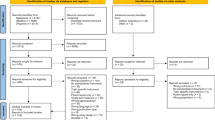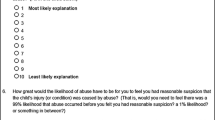Abstract
Purpose
Studies assessing the influence of neonatal complications on children’s dental behaviour are lacking. We aimed to investigate whether prematurity, birth weight, and history of neonatal intensive care unit (NICU) hospitalisation are associated with distress during dental examination in children.
Methods
This preliminary longitudinal, retrospective study included 42 5- and 6-year-old children. Distress during dental examination was assessed using the observational FLACC Pain Assessment Tool through video files. Children self-reported their pain (Faces Pain Scale-Revised) at the end of the session. Information about neonatal complications was obtained through medical records. Bivariate analysis was performed (P < 0.05).
Results
Children with low birth weight (P = 0.047) and toothache history (P = 0.005) had higher frequency of distress during dental examination. There was no association between distress, prematurity and history of NICU hospitalisation (P > 0.05).
Conclusions
Health professionals can help to disseminate the knowledge that children with history of low birth weight are more prone to perceive distress with apparently painless procedures.

Similar content being viewed by others
References
Babl FE, Crellin D, Cheng J, et al. The use of the faces, legs, activity, cry and consolability scale to assess procedural pain and distress in young children. Pediatri Emerg Care. 2012;28:1281–96.
Bieri D, Reeve RA, Champion GD, Addicoat L, Ziegler JB. The Faces Pain Scale for the self-assessment of the severity of pain experienced by children: development, initial validation, and preliminary investigation for ratio scale properties. Pain. 1990;41:139–50.
Blencowe H, Cousens S, Oestergaard MZ, et al. National, regional, and worldwide estimates of preterm birth rates in the year 2010 with time trends since 1990 for selected countries: a systematic analysis and implications. Lancet. 2012;379:2162–72.
Bouza H. The impact of pain in the immature brain. J Matern Fetal Neonatal Med. 2009;22:722–32.
Brogårdh-Roth S, Stjernqvist K, Matsson L. Dental behavioural management problems and dental caries prevalence in 3- to 6-year-old Swedish children born preterm. Int J Paediatr Dent. 2008;18:341–7.
Burnett AC, Scratch SE, Lee KJ, et al. Victorian Infant Collaborative Study Group. Executive function in adolescents born %3c 1000 g or %3c 28 weeks: a prospective cohort study. Pediatrics. 2015;135:e826–e834834.
Carbajal R, Rousset A, Danan C, et al. Epidemiology and treatment of painful procedures in neonates in intensive care units. JAMA. 2008;300:60–70.
Charry CLE, Piola JS, Linhares MBM, Silva JA. Validity and reliability assessment of the Brazilian version of the Faces Pain Scale-Revised. Psychol Neurosci. 2014;7:55–9.
Conrad AL, Richman L, Lindgren S, Nopoulos P. Biological and environmental predictors of behavioral sequelae in children born preterm. Pediatrics. 2010;125:e83–e8989.
Delobel-Ayoub M, Arnaud C, White-Koning M, et al. Behavioral problems and cognitive performance at 5 years of age after very preterm birth: the EPIPAGE study. Pediatrics. 2009;123:1485–92.
Farooqi A, Hägglöf B, Sedin G, Gothefors L, Serenius F. Mental health and social competencies of 10-to 12-year-old children born at 23 to 25 weeks of gestation in the 1990s: a Swedish national prospective follow-up study. Pediatrics. 2007;120:118–33.
Gaspardo CM, Cassiano RGM, Gracioli SMA, Furini GCB, Linhares MBM. Effects of neonatal pain and temperament on attention problems in toddlers born preterm. J Pediatr Psychol. 2001;43:342–51.
Gomes HS, Vieira LA, Costa PS, Batista AC, Costa LR. Professional dental prophylaxis increases salivary cortisol in children with dental behavioural management problems: a longitudinal study. BMC Oral Health. 2016;16:74.
Hack M, Taylor HG, Schluchter M, et al. Behavioral outcomes of extremely low birth weight children at age 8 years. J Dev Behav Pediatr. 2009;30:122–30.
Hicks CL, von Baeyer CL, Spafford PA, van Korlaar I, Goodenough B. The Faces Pain Scale-Revised: toward a common metric in pediatric pain measurement. Pain. 2001;93:173–83.
Johnson S, Marlow N. Preterm birth and childhood psychiatric disorders. Pediatr Res. 2011;69:11R–8R.
Johnston C, Barrington KJ, Taddio A, Carbajal R, Filion F. Pain in Canadian NICUs: have we improved over the past 12 years? Clin J Pain. 2011;27:225–32.
Klein VC, Gaspardo CM, Martinez FE, Grunau RE, Linhares MB. Pain and distress reactivity and recovery as early predictors of temperament in toddlers born preterm. Early Hum Dev. 2009;85:569–76.
Latimer K, Wilson P, Kemp J, et al. Disruptive behaviour disorders: a systematic review of environmental antenatal and early years risk factors. Child Care Health Dev. 2012;38:611–28.
Merkel SI, Voepel-Lewis T, Shayevitz JR, Malviya S. The FLACC: a behavioral scale for scoring postoperative pain in young children. Pediatr Nurs. 1997;23:293–7.
Puffer RR, Serrano C. Patterns of birth weight. Washington, DC: PAHO; 1987.
Ramos-Jorge ML, Marques LS, Paiva SM, Serra-Negra JM, Pordeus IA. Predictive factors for child behaviour in the dental environment. Eur Arch Paediatr Dent. 2006;7:253–7.
Schwaller F, Fitzgerald M. The consequences of pain in early life: injury-induced plasticity in developing pain pathways. Eur J Neurosci. 2014;39:344–52.
Scott MN, Taylor HG, Fristad MA, et al. Behavior disorders in extremely preterm/extremely low birth weight children in kindergarten. J Dev Behav Pediatr. 2012;33:202–13.
Tomlinson D, von Baeyer CL, Stinson JN, Sung L. A systematic review of faces scales for the self-report of pain intensity in children. Pediatrics. 2010;126:e1168–e1198198.
Tsang AK. The special needs of preterm children—an oral health perspective. Dent Clin North Am. 2016;60:737–56.
WHO. Recommended definitions, terminology and format for statistical tables related to the perinatal period and use of a new certificate for cause perinatal period and use of a new certificate for cause perinatal deaths. Modifications recommended by FIGO as amended October 14, 1976. Acta Obastet Gynecol Scand. 1977;56:247–53.
World Health Organization. Oral health surveys: basic methods. 3rd ed. Geneva: ORH/EPID; 1987.
Xia B, Wang CL, Ge LH. Factors associated with dental behaviour management problems in children aged 2–8 years in Beijing, China. Int J Paediatr Dent. 2011;21:200–9.
Zhou Y, Humphris GM. Reassurance and distress behavior in preschool children undergoing dental preventive care procedures in a community setting: a multilevel observational study. Ann Behav Med. 2014;48:100–11.
Funding
APM received Master of Science scholarship from the Fundação de Amparo à Pesquisa do Estado de Goiás (FAPEG). PCF receives Post-doctoral fellowship scholarship from the Coordenação de Aperfeiçoamento de Pessoal de Nível Superior (Capes). LRC receives Research Productivity scholarship from the Conselho Nacional de Desenvolvimento Científico e Tecnológico (CNPq). These funding agencies have not interfered in any stage of the preparation of this study and this manuscript.
Author information
Authors and Affiliations
Corresponding author
Ethics declarations
Conflict of interest
The authors declare that they have no conflict of interest.
Ethical approval
All the procedures performed in this study involving human participants were in accordance with the ethical standards of the institutional research committee and with the 1964 Helsinki Declaration and its later amendments, as well as with the Brazilian national guidelines.
Informed consent
Informed consent was obtained from the adults responsible for all individual participants included in this study.
Additional information
Publisher's Note
Springer Nature remains neutral with regard to jurisdictional claims in published maps and institutional affiliations.
Rights and permissions
About this article
Cite this article
Mundim, A.P., Corrêa-Faria, P. & Costa, L.R. Do preschoolers with adverse birth outcomes have more distress during dental examination?. Eur Arch Paediatr Dent 20, 571–576 (2019). https://doi.org/10.1007/s40368-019-00438-4
Received:
Accepted:
Published:
Issue Date:
DOI: https://doi.org/10.1007/s40368-019-00438-4




